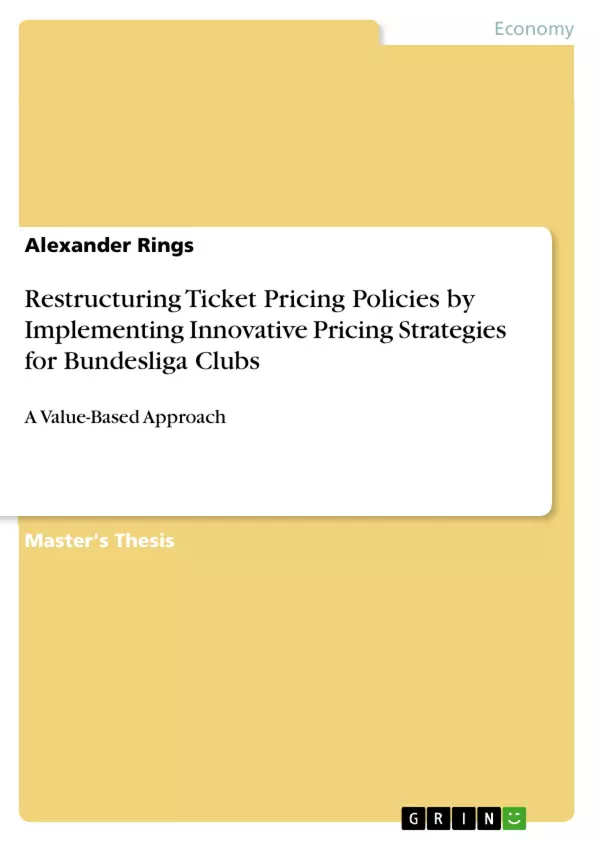For hundreds of years people have been highly affine to any kind of sports. Thousands of people regularly watch sports events online and offline and in society the topic of a team‟s or an individual‟s performance is always passionately discussed. Taking a look at Europe the most popular sport is football. Mughai (2016, p. 13) elaborates that football – or sometimes called soccer to avoid interchanging with American football – is globally ranked first in terms of popularity. Supporters that are very passionate about their team are visiting the huge football stadiums week by week. As the capacity of a stadium is limited sometimes fans are even purchasing their entrance tickets weeks or months ahead of the event itself. Especially the German Bundesliga has been facing an enormous interest growth within the last years resulting in an average of 42.609 visitors per match day making the league the most visited one in Europe. (DFL, 2015, p. 22f)
Similar to the ever-growing popularity of sports, the costs are rising. This is caused by mounting player salaries, increased transfer fees and other operational expenses. (Drayer, Lee & Shapiro, 2012, p. 184; Breuer & Kemper, 2015, p. 142) Sport clubs therefore need to steadily open up and augment their sources of revenue: match day revenues, advertising, broadcasting, transfer fees and merchandising. (DFL, 2015, p. 26f) Some of these revenue streams can be actively influenced by the Bundesliga clubs whilst others are hard to affect. One of the determinants that can be modified is ticket pricing.
The objective of this Master Thesis is to explain the prevailing pricing strategy in the German Bundesliga and to present innovative, value-based pricing approaches which can be tested. Creating an understanding of the fans‟ willingness to pay and factors having impact on the purchase decision making process, a gap in research is supposed to be filled. In this Master Thesis the author aims to find sufficient, relevant, reliable and empirically proven answers to the following research questions:
1) Why have innovative value-based pricing strategies like dynamic pricing not yet been implemented in the German Bundesliga?
2) To what extant are fans willing to pay different prices depending on dynamic factors?
3) What determinants need to be taken care of when changing the prevailing pricing strategies of Bundesliga clubs?
Inhaltsverzeichnis (Table of Contents)
- Introduction
- Conceptual Approach
- Situation Analysis and Benchmarking of the Sports Industry
- The European Sports Industry
- Ticket Pricing Situation in Europe
- Demand Drivers
- The American Sports Industry
- Theoretical Pricing Approaches
- Price Strategies as Profit Driver
- Price Differentiation
- Price Strategies Managing Demand and Capacity
- Revenue Management
- Dynamic Pricing
- Dynamic Pricing Attempts in America
- Usability of Dynamic Pricing Policies in the Soccer Industry
- Situation Analysis and Benchmarking of the Sports Industry
- Price Setting of Borussia Mönchengladbach
- Season Tickets
- Match Day Tickets
- Empirical Evaluation of the Price Setting
- Bias Analysis
- General Information for Clustering Purposes
- Evaluation of General Information
- Conclusion of General Information Survey Results
- Van Westendorp Approach
- Evaluation of Survey Results
- Evaluation of the Stadium as a Whole
- Evaluation of the North Curve
- Evaluation of the South Curve
- Evaluation of the West Tribune
- Evaluation of the East Tribune
- Evaluation of the Whole Stadium Except North Curve
- Conclusion of Van Westendorp Survey Results
- Evaluation of Survey Results
- Dynamic Ticket Pricing Approach
- Evaluation of Survey Results
- Conclusion of Dynamic Pricing Survey Results
- Discussing the Possibility of a New Pricing Strategy
- Price Implementation Recommendation
- Conclusion
- Recommendation for Further Research
Zielsetzung und Themenschwerpunkte (Objectives and Key Themes)
This Master Thesis examines the potential of implementing innovative pricing strategies for Bundesliga clubs, specifically focusing on Borussia Mönchengladbach, within the context of restructuring ticket pricing policies. The aim is to analyze the current pricing landscape, identify potential areas for improvement, and ultimately propose a value-based approach to ticket pricing that optimizes revenue while ensuring fan satisfaction.
- The current state of ticket pricing in the European and American sports industries
- The application of theoretical pricing approaches to the Bundesliga context
- The analysis of fan preferences and price sensitivity through empirical research
- The feasibility of implementing dynamic pricing strategies in the soccer industry
- The development of a practical recommendation for restructuring ticket pricing policies for Borussia Mönchengladbach
Zusammenfassung der Kapitel (Chapter Summaries)
The thesis begins by providing an overview of the European and American sports industries, specifically focusing on ticket pricing trends and demand drivers. Chapter 2 explores relevant theoretical pricing approaches, including price strategies as profit drivers, price differentiation, and demand management techniques such as revenue management and dynamic pricing. Chapter 3 delves into the specific price setting of Borussia Mönchengladbach, examining both season and match-day tickets.
Chapter 4 presents the empirical evaluation of the current price setting, utilizing survey data to analyze fan preferences and price sensitivity. This chapter explores the results of both the Van Westendorp price sensitivity meter and a dynamic pricing survey. Finally, Chapter 5 discusses the feasibility of implementing a new pricing strategy and presents a practical recommendation for Borussia Mönchengladbach, aiming to balance revenue generation with fan satisfaction.
Schlüsselwörter (Keywords)
This Master Thesis focuses on the intersection of sports economics, pricing strategies, and fan behavior within the context of the Bundesliga. Key terms and concepts include ticket pricing, dynamic pricing, revenue management, price sensitivity, fan preferences, Bundesliga, Borussia Mönchengladbach, and value-based pricing.
- Quote paper
- Alexander Rings (Author), 2016, Restructuring Ticket Pricing Policies by Implementing Innovative Pricing Strategies for Bundesliga Clubs, Munich, GRIN Verlag, https://www.grin.com/document/340239



